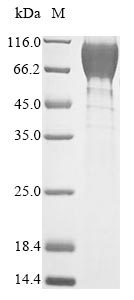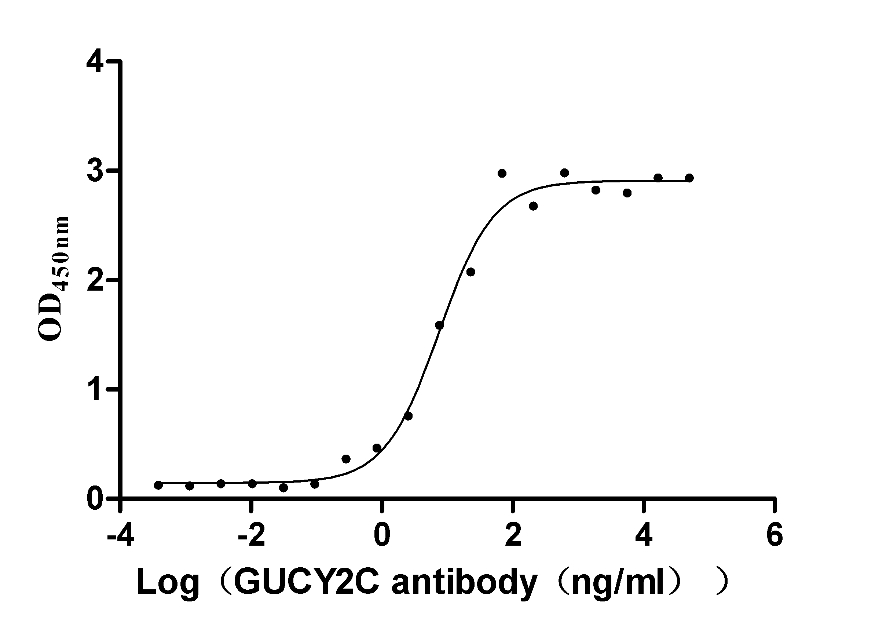Recombinant Mouse Heat-stable enterotoxin receptor (Gucy2c), partial
In Stock-
货号:CSB-MP664972MO
-
规格:¥3960
-
图片:
-
其他:
产品详情
-
纯度:Greater than 85% as determined by SDS-PAGE.
-
基因名:
-
Uniprot No.:
-
别名:Gucy2c; Guc2c; Heat-stable enterotoxin receptor; STA receptor; EC 4.6.1.2; Guanylyl cyclase C; GC-C; Intestinal guanylate cyclase
-
种属:Mus musculus (Mouse)
-
蛋白长度:Extracellular Domain
-
来源:Mammalian cell
-
分子量:52.1 kDa
-
表达区域:20-433aa
-
氨基酸序列VFWASQVRQNCRNGSYEISVLMMDNSAYKEPMQNLREAVEEGLDIVRKRLREADLNVTVNATFIYSDGLIHKSGDCRSSTCEGLDLLREITRDHKMGCALMGPSCTYSTFQMYLDTELNYPMISAGSYGLSCDYKETLTRILPPARKLMYFLVDFWKVNNASFKPFSWNSSYVYKNGSEPEDCFWYLNALEAGVSYFSEVLNFKDVLRRSEQFQEILTGHNRKSNVIVMCGTPESFYDVKGDLQVAEDTVVILVDLFSNHYFEENTTAPEYMDNVLVLTLPSEQSTSNTSVAERFSSGRSDFSLAYLEGTLLFGHMLQTFLENGENVTGPKFARAFRNLTFQGFAGPVTLDDSGDIDNIMSLLYVSLDTRKYKVLMKYDTHKNKTIPVAENPNFIWKNHKLPNDVPGLGPQILM
Note: The complete sequence including tag sequence, target protein sequence and linker sequence could be provided upon request. -
蛋白标签:N-terminal 10xHis-tagged and C-terminal Myc-tagged
-
产品提供形式:Liquid or Lyophilized powder
Note: We will preferentially ship the format that we have in stock, however, if you have any special requirement for the format, please remark your requirement when placing the order, we will prepare according to your demand. -
缓冲液:Tris-based buffer,50% glycerol
-
储存条件:Store at -20°C/-80°C upon receipt, aliquoting is necessary for mutiple use. Avoid repeated freeze-thaw cycles.
-
保质期:The shelf life is related to many factors, storage state, buffer ingredients, storage temperature and the stability of the protein itself.
Generally, the shelf life of liquid form is 6 months at -20°C/-80°C. The shelf life of lyophilized form is 12 months at -20°C/-80°C. -
货期:3-7 business days
-
注意事项:Repeated freezing and thawing is not recommended. Store working aliquots at 4°C for up to one week.
-
Datasheet & COA:Please contact us to get it.
相关产品
靶点详情
-
功能:Receptor for the E.coli heat-stable enterotoxin (E.coli enterotoxin markedly stimulates the accumulation of cGMP in mammalian cells expressing GC-C). Also activated by the endogenous peptide guanylin.
-
基因功能参考文献:
- Relative to controls, guanylate cyclase C knockout mice develop severe systemic illness following oral Salmonella infection, characterized by disrupted intestinal mucus layer, elevated cytokines and organ bacterial load, and reduced animal survival. PMID: 29367634
- Loss of Gucy2c expression is associated with Acute Radiation-Induced GI Syndrome. PMID: 28916678
- Findings show how caloric suppression of the guanylin-GUCY2C signaling axis links obesity to negation of a universal tumor suppressor pathway in colorectal cancer. PMID: 26773096
- The GC-C signaling pathway blunts colonic mucosal inflammation that is initiated by systemic cytokine burst or loss of mucosal immune cell immunosuppression. PMID: 24244444
- GC-C signaling is an essential component of host defense during murine enteric infection by reducing bacterial load and preventing systemic dissemination of attaching/effacing-lesion forming bacterial pathogens such as C. rodentium. PMID: 24004613
- guanylate cyclase-C PMID: 23739979
- GUCY2C opposes systemic genotoxic tumorigenesis by regulating AKT-dependent intestinal barrier integrity PMID: 22384056
- The role for GUCY2C-directed CD8(+) T cells targeting specific epitopes in antitumor efficacy. PMID: 22057677
- Data show that silencing of GUCY2C in mice disrupts satiation, resulting in hyperphagia and subsequent obesity and metabolic syndrome. PMID: 21865642
- a novel role for GC-C signaling in facilitating mucosal wounding and inflammation, and further suggest that this may be mediated, in part, through control of RELMbeta production PMID: 21555532
- midbrain dopamine neurons express GC-C; GC-C activation potentiates excitatory response mediated by glutamate and acetylcholine receptors via activity of PKG; GC-C knockout mice exhibit hyperactivity and attention deficit PMID: 21835979
- GCC signaling plays a protective role in the integrity of the intestinal mucosal barrier by regulating myosin light chain kinase activation and tight junction disassembly. PMID: 21305056
- There is a previously unappreciated interaction between sex and GCC signaling restricting crypt cell proliferation. PMID: 20443837
- GUCY2C is a tumor suppressor that controls proliferation and metabolism of intestinal epithelial cells by inactivating AKT signaling PMID: 19737566
- transmembrane guanylyl cyclase C is a key mediator of acid-stimulated duodenal bicarbonate secretion PMID: 12881226
- guanylin, uroguanylin, and E coli enterotoxin act on the mouse kidney, in part, through a cGMP-dependent, GC-C-independent mechanism, causing significant natriuresis by renal tubular processes PMID: 14675035
- two signaling pathways for guanylin peptides in principal cells of mouse cortical kidney collecting duct is not mediated by guanylate cyclase C PMID: 16105031
- GCC suppresses intestinal tumor initiation and growth by maintaining genomic integrity and restricting proliferation. PMID: 17681179
- GC-C coordinates component processes maintaining homeostasis of the crypt progenitor compartment. PMID: 17974601
- These findings demonstrate increased radiosensitivity of intestinal epithelial cells in guanylate cyclase C (GCC) knockout mice, and establish a role for GCC in preventing apoptosis. PMID: 19221018
- the role of the linker region in receptor guanylyl cyclases PMID: 19648115
显示更多
收起更多
-
亚细胞定位:Cell membrane; Single-pass type I membrane protein. Endoplasmic reticulum membrane; Single-pass type I membrane protein.
-
蛋白家族:Adenylyl cyclase class-4/guanylyl cyclase family
-
数据库链接:
KEGG: mmu:14917
STRING: 10090.ENSMUSP00000032338
UniGene: Mm.222729
Most popular with customers
-
Recombinant Human Heat-stable enterotoxin receptor (GUCY2C), partial (Active)
Express system: Mammalian cell
Species: Homo sapiens (Human)
-
Recombinant Human Prolactin receptor (PRLR), partial (Active)
Express system: Mammalian cell
Species: Homo sapiens (Human)
-
Recombinant Human Tissue factor pathway inhibitor (TFPI), partial (Active)
Express system: Mammalian cell
Species: Homo sapiens (Human)
-
Recombinant Human Claudin-6 (CLDN6)-VLPs (Active)
Express system: Mammalian cell
Species: Homo sapiens (Human)
-
Recombinant Mouse Cytotoxic and regulatory T-cell molecule (Crtam), partial (Active)
Express system: Mammalian cell
Species: Mus musculus (Mouse)
-
Recombinant Human Serotransferrin(TF) (Active)
Express system: Mammalian cell
Species: Homo sapiens (Human)
-
Recombinant Human Gastric inhibitory polypeptide receptor(GIPR),partial (Active)
Express system: Mammalian cell
Species: Homo sapiens (Human)
-
Recombinant Human C-C chemokine receptor type 9 (CCR9)-VLPs (Active)
Express system: Mammalian cell
Species: Homo sapiens (Human)






-AC1.jpg)














